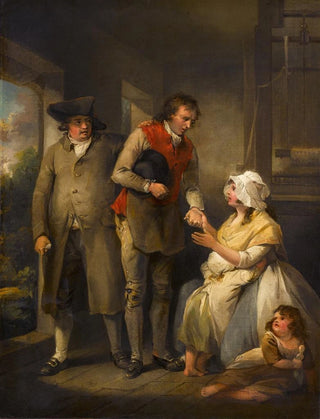Art print | The Power of Justice - George Morland


View from behind

Frame (optional)
In the vibrant universe of art, certain works stand out for their ability to transcend time and evoke profound reflections on the human condition. "The Power of Justice" by George Morland is one of those creations that provoke and fascinate. This piece, imbued with symbolism, invites the viewer to delve into a world where justice, often personified, stands as a central figure—both protective and relentless. Through this art print, the very essence of the original work is preserved, allowing appreciation of the richness of its message and the depth of its interpretation.
Style and uniqueness of the work
Morland, known for his skill in capturing everyday life and human emotions, deploys here a style that blends realism and idealization. The chosen colors, both vivid and nuanced, create an atmosphere that is at once serene and unsettling. The characters, carefully arranged within the composition, seem to interact with their surrounding environment, reinforcing the work's message. The light, omnipresent, plays a crucial role, illuminating faces and expressions, revealing internal struggles and aspirations of the protagonists. This play of light and shadow gives the piece a captivating dynamic, where each gaze upon the canvas can unveil a new facet. Thus, "The Power of Justice" is not merely a static representation but a true dialogue between the artist, their characters, and the viewer.
The artist and his influence
George Morland, an emblematic figure of the 18th century, mastered navigating between different artistic currents while developing a personal style unique to him. Influenced by the masters of the past, he integrated elements of classical painting while focusing on depicting daily life of his time. His work reflects a particular sensitivity towards social themes, human nature, and the injustices of his era. By addressing subjects such as justice, Morland does not merely paint; he questions and provokes critical reflection in the viewer. His legacy endures, inspiring many contemporary artists who see in

Matte finish

View from behind

Frame (optional)
In the vibrant universe of art, certain works stand out for their ability to transcend time and evoke profound reflections on the human condition. "The Power of Justice" by George Morland is one of those creations that provoke and fascinate. This piece, imbued with symbolism, invites the viewer to delve into a world where justice, often personified, stands as a central figure—both protective and relentless. Through this art print, the very essence of the original work is preserved, allowing appreciation of the richness of its message and the depth of its interpretation.
Style and uniqueness of the work
Morland, known for his skill in capturing everyday life and human emotions, deploys here a style that blends realism and idealization. The chosen colors, both vivid and nuanced, create an atmosphere that is at once serene and unsettling. The characters, carefully arranged within the composition, seem to interact with their surrounding environment, reinforcing the work's message. The light, omnipresent, plays a crucial role, illuminating faces and expressions, revealing internal struggles and aspirations of the protagonists. This play of light and shadow gives the piece a captivating dynamic, where each gaze upon the canvas can unveil a new facet. Thus, "The Power of Justice" is not merely a static representation but a true dialogue between the artist, their characters, and the viewer.
The artist and his influence
George Morland, an emblematic figure of the 18th century, mastered navigating between different artistic currents while developing a personal style unique to him. Influenced by the masters of the past, he integrated elements of classical painting while focusing on depicting daily life of his time. His work reflects a particular sensitivity towards social themes, human nature, and the injustices of his era. By addressing subjects such as justice, Morland does not merely paint; he questions and provokes critical reflection in the viewer. His legacy endures, inspiring many contemporary artists who see in






